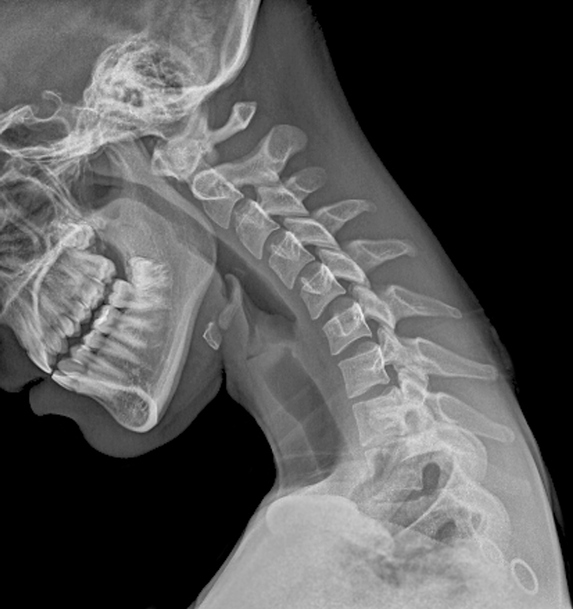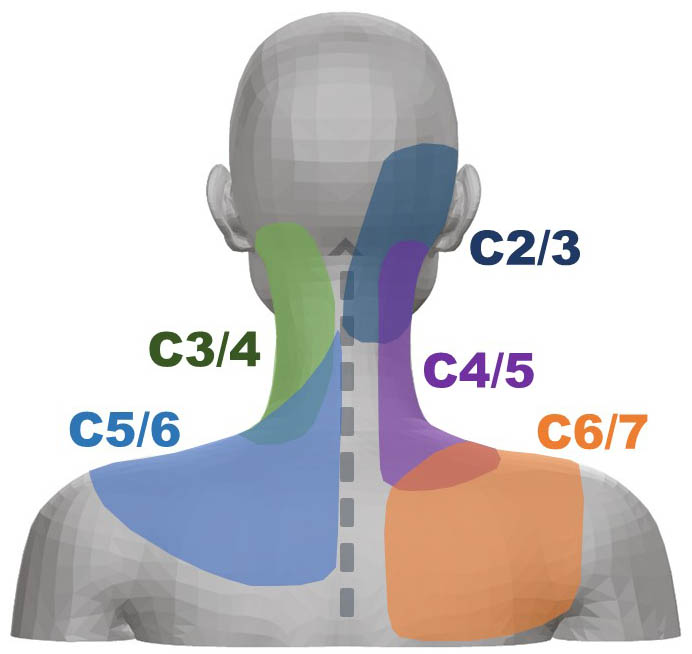You’ve Been in a Collision
You were in a crash. Your body whiplashed in your seat when two tons (or more) of metal smashed into your vehicle. Your neck, back, or both having been hurting ever since. It’s on one side or the other, or both. You thought it would get better, but it hasn’t. Some days are better, but it’s always there, some days worse than others. You try to adapt to your permanent neck and back pain, but pain medication and avoiding certain activities aren’t enough. And your doctors say they don’t know what’s wrong with you, and can’t fix your injuries.
What are you supposed to do?
Fortunately, there’s a procedure that may give you your life back.
The anatomy of the human spine
We’ve probably all seen models of the human spine, but few of us have given it much thought. Until we or our loved ones are injured.

But facet joints weren’t designed to withstand the force of even small crashes. In a collision, energy is transferred from the striking vehicle to the struck vehicle, and through occupants’ bodies. These forces cause the spine to violently “whiplash” forward and backwards, like a whip, causing vertebrae to rotate out of alignment and collide with adjacent vertebra. This puts more pressure on the facet joints than they can naturally handle, and causes microscopic tearing, fractures, and other injuries that don’t always show up on X-rays, MRIs, and other diagnostic imaging.
Facet joint injuries are the most common source of chronic pain following car crashes. Usually, the underlying facet joint injury isn’t a problem, except for the chronic pain it causes. Victims often experience pain on one side or the other, but bilateral facet joint injuries can cause pain on both sides of the neck and back. Facet joint pain radiates out from the affected spinal structure, and in the case of cervical injuries, can cause headaches and shoulder pain. The severity of pain often fluctuates, and can be aggravated by simple daily tasks like bending over, picking things up, and sitting for long periods of time. But as long as the facet joint remains injured, the pain is always there, to one degree or another.
Some facet joint injuries heal after a few weeks or months. For some car crash victims, however, facet joint injuries will never go away on their own. If the pain lasts for a year or more, the injuries causing it are likely permanent.
Radiofrequency neurotomy (i.e. radiofrequency ablation)
Permanent facet joint injuries change lives forever. Parents avoid picking up toddlers for fear of aggravating their chronic pain. Shopping causes flareups, travel becomes a nightmare. Sitting at a computer becomes so painful that facet joint injury victims have trouble concentrating, leading to mental fog exacerbated by a lack of comfortable sleep. Family, friends, and colleagues notice changes in victims’ personalities and abilities.
Without proper care, car crash victims with permanent facet joint injuries can do little more than grit their teeth, bearing the pain as best they can, trying to ignore their symptoms. Over time, chronic pain becomes a new normal. The pain is like a pilot light, always there, always burning, waiting for something to stoke the flame and cause another flare up. Finding no permanent relief from pain pills, chiropractic adjustments, or physical therapy, these victims may give up on medical treatment.
But it doesn’t have to be that way. Thankfully, there is a medical procedure that can alleviate painful facet joint injuries for months or years at a time.
That procedure is called “radiofrequency neurotomy” (or “RFN,” otherwise known as “radiofrequency ablation”). Pain from permanently injured facet joints is transmitted to the brain through “medial branch” nerves. RFN turns off those pain signals by cauterizing the medial branch nerves connected to an injured facet joint. Once the nerve is burned, it can no longer send pain signals.
The procedure is well recognized in the medical community. For example, prestigious institutions like the Mayo Clinic perform RFNs to help their patients cope with chronic facet joint pain.
Unfortunately, RFNs do not provide permanent pain relief. Typical RFN relief lasts from nine months to two years. That’s how long it usually takes for a cauterized medial branch nerve to regenerate, and resume sending pain signals from permanently injured facet joints. Repeat RFN procedures reinstate pain relief after pain returns.
Diagnosing permanent facet joint injuries
RFN is a serious—and expensive—procedure. That’s why it’s important to know exactly which facet joint are causing pain, and to be sure RFN will provide relief before a doctor cauterizes medial branch nerves. Some insurance companies won’t pay for RFNs unless proper testing is performed.

Once the pain doctor identifies the suspected facet joint, she can test the joint to confirm her hypothesis. The test is called a “medial branch block.” During these tests, doctors use pharmaceutical anesthetics (lidocaine, for example) to block pain signals from suspected facet joint injuries to the patient’s brain. If the anesthetic provides relief for an appropriate period of time, the doctor knows the anesthetized nerve is connected to an injured facet joint. If the medial branch blocks don’t provide appropriate relief, the doctor knows another facet joint—or something else—must be causing the patient’s chronic pain.
Patients cannot fake the results of medial branch block tests. They aren’t told which facet joints are being anesthetized, and don’t know how long the anesthetic is supposed to last. As a result of these blind tests, doctors can take the guesswork out of treating chronic pain.
Because facet joint injuries are often microscopic, and often are invisible on most diagnostic imaging, medial branch blocks are the only way to diagnose facet joint injuries. If your doctors say they can’t see anything wrong with your spine on X-rays, MRIs, or CT scans, you’re not alone. Thousands of people just like you have been told there’s no “objective” injury to your spine. Like many of these other car crash victims, medial branch block tests may show that you’re a candidate for RFN treatments.
Finding the right doctor
Not all medical providers are created equal. Unfortunately, too many doctors, when diagnosing spinal injuries, fail to recognize the tell-tale signs of permanent facet joint injuries. Others test the wrong facet joints, and give up when initial medial branch block tests are inconclusive. And some doctors fail to understand that RFNs are not permanent. Instead of trusting peer-reviewed scientific literature, they hold unscientific opinions that only one or a few RFNs are needed in an injured person’s lifetime.
As a result, facet joint injury patients are often misdiagnosed. Or, when these patients’ pain returns, some providers fail to repeat the RFN procedure to reinstate their patients’ pain relief. If a facet joint injury victim doesn’t get appropriate care, they may believe the RFN doesn’t work, or isn’t an effective option for them.
That’s why it’s so important to consult with the right RFN doctor. Our crash accident clients have been treated by some of the best facet joint injury doctors in the country, who are able to give their patients complete (though temporary) relief of chronic neck and back pain.